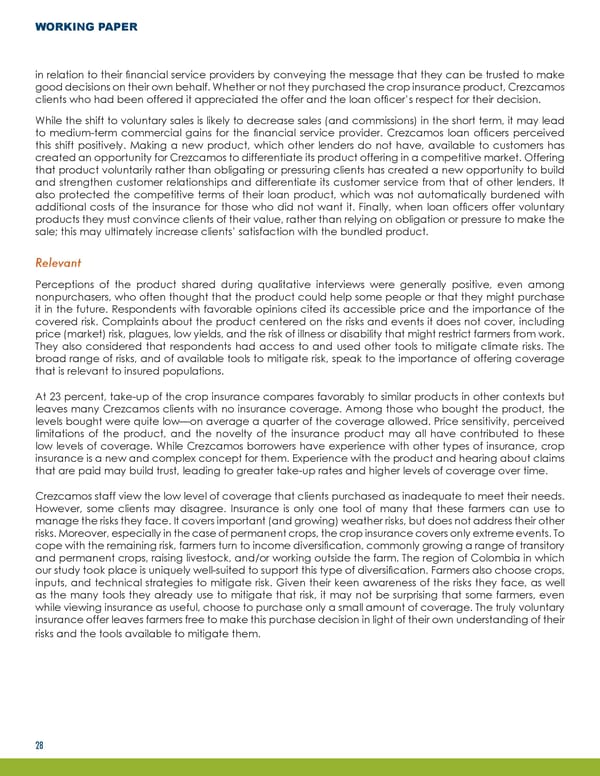WORKING PAPER in relation to their financial service providers by conveying the message that they can be trusted to make good decisions on their own behalf. Whether or not they purchased the crop insurance product, Crezcamos clients who had been offered it appreciated the offer and the loan officer’s respect for their decision. While the shift to voluntary sales is likely to decrease sales (and commissions) in the short term, it may lead to medium-term commercial gains for the financial service provider. Crezcamos loan officers perceived this shift positively. Making a new product, which other lenders do not have, available to customers has created an opportunity for Crezcamos to differentiate its product offering in a competitive market. Offering that product voluntarily rather than obligating or pressuring clients has created a new opportunity to build and strengthen customer relationships and differentiate its customer service from that of other lenders. It also protected the competitive terms of their loan product, which was not automatically burdened with additional costs of the insurance for those who did not want it. Finally, when loan officers offer voluntary products they must convince clients of their value, rather than relying on obligation or pressure to make the sale; this may ultimately increase clients’ satisfaction with the bundled product. Relevant Perceptions of the product shared during qualitative interviews were generally positive, even among nonpurchasers, who often thought that the product could help some people or that they might purchase it in the future. Respondents with favorable opinions cited its accessible price and the importance of the covered risk. Complaints about the product centered on the risks and events it does not cover, including price (market) risk, plagues, low yields, and the risk of illness or disability that might restrict farmers from work. They also considered that respondents had access to and used other tools to mitigate climate risks. The broad range of risks, and of available tools to mitigate risk, speak to the importance of offering coverage that is relevant to insured populations. At 23 percent, take-up of the crop insurance compares favorably to similar products in other contexts but leaves many Crezcamos clients with no insurance coverage. Among those who bought the product, the levels bought were quite low—on average a quarter of the coverage allowed. Price sensitivity, perceived limitations of the product, and the novelty of the insurance product may all have contributed to these low levels of coverage. While Crezcamos borrowers have experience with other types of insurance, crop with the product and hearing about claims insurance is a new and complex concept for them. Experience that are paid may build trust, leading to greater take-up rates and higher levels of coverage over time. Crezcamos staff view the low level of coverage that clients purchased as inadequate to meet their needs. However, some clients may disagree. Insurance is only one tool of many that these farmers can use to manage the risks they face. It covers important (and growing) weather risks, but does not address their other risks. Moreover, especially in the case of permanent crops, the crop insurance covers only extreme events. To cope with the remaining risk, farmers turn to income diversification, commonly growing a range of transitory and permanent crops, raising livestock, and/or working outside the farm. The region of Colombia in which our study took place is uniquely well-suited to support this type of diversification. Farmers also choose crops, inputs, and technical strategies to mitigate risk. Given their keen awareness of the risks they face, as well as the many tools they already use to mitigate that risk, it may not be surprising that some farmers, even while viewing insurance as useful, choose to purchase only a small amount of coverage. The truly voluntary insurance offer leaves farmers free to make this purchase decision in light of their own understanding of their risks and the tools available to mitigate them. 28
 Responsible Bundling of Microfinance Services Page 30 Page 32
Responsible Bundling of Microfinance Services Page 30 Page 32